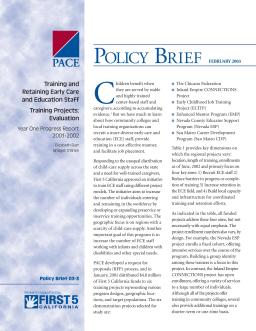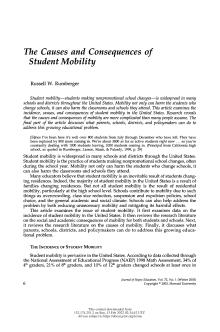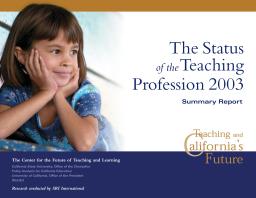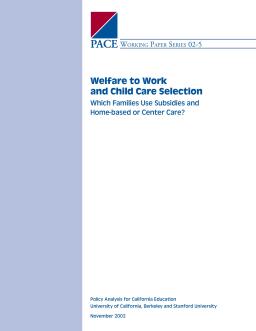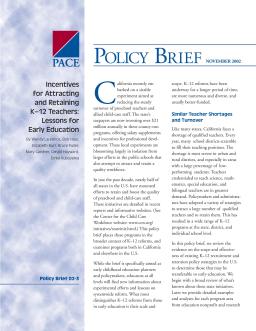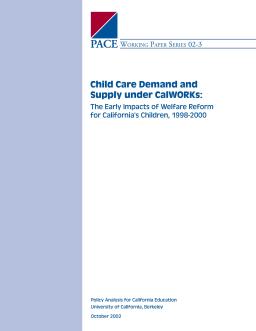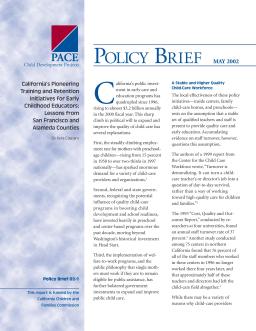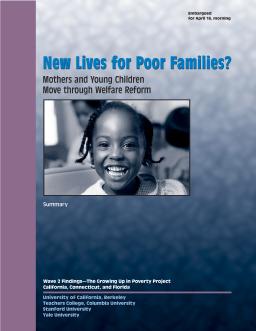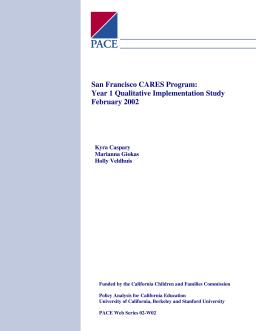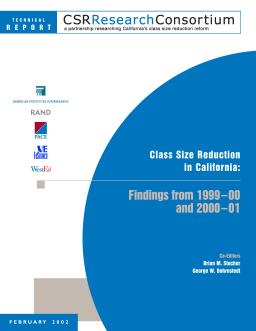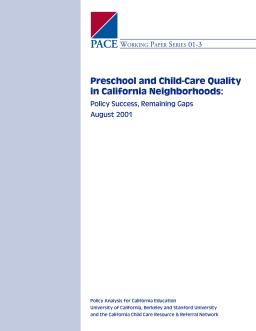Year One Progress Report, 2001–2002
Published
Summary
This policy brief examines the effectiveness of childcare retention incentive (CRI) programs in selected California counties. It assesses program design, participant characteristics, training activities, and retention rates among early care and education staff. The study aims to identify the impact of CRI programs on the stability and training of the ECE workforce, which is critical for improving the quality of care for children.
Evaluation Year One Progress—Report 2001–02
Published
Summary
First 5 California approved an initiative to train early care and education (ECE) staff in regions with a scarcity of childcare supply. Six training projects were selected, which provide community college training and additional training on a shorter-term or one-time basis. The goal is to increase the number of individuals entering and remaining in the ECE workforce and to increase the number of ECE staff working with infants and children with disabilities and other special needs.
Published
Summary
This paper examines the incidence, causes, and consequences of student mobility in the US. Mobility not only harms the students who change schools, but also the classrooms and schools they attend. The causes and consequences of mobility are more complicated than many people assume. The authors suggest ways for parents, schools, districts, and policymakers to address this growing educational problem.
Summary Report
Published
Summary
This report argues that the state of California needs to prioritize better education for all children with a sustained long-term investment of resources and leadership. Despite political upheaval and fiscal problems, there is a consensus for better education. The authors suggest that the issue requires a response as intense and sustained as the state's response to natural disasters, and calls for a system of teacher development to ensure all teachers have the necessary knowledge and skills to meet academic standards.
Which Families to Serve First? Who Will Respond?
Published
Summary
This paper discusses extending access to preschool for families in California, focusing on targeting priorities to yield strong enrollment demand and discernible effects on young children's early development and school readiness. It analyzes different targeting mechanisms and suggests experimenting with alternative expansion strategies, rather than investing exclusively in one method. The report also describes which communities would benefit most and considers the criteria for judging the wisdom of targeting options.
Assessing Balance and Substance
Published
Summary
Arnold Schwarzenegger received lopsided media attention during the first weeks of his campaign, according to a UC study. 87% of the 164 stories reported by the New York Times focused on Schwarzenegger. Less coverage was given to Bustamante, who was out-polling the actor at the time. The study found little coverage of policy issues and that Schwarzenegger’s personal history and character received more attention. Lesser-known candidates, including Peter Camejo and Arianna Huffington, received proportionally less coverage.
Which Families Use Subsidies and Home-Based or Center Care?
Published
Summary
Public spending on childcare has increased, but low-income families still face barriers to accessing subsidies. This working paper examines the choices made by 1,974 parents in California who moved from welfare to work and needed childcare. The study found that parents relied on a mix of formal and informal childcare options, and that the expansion of one form of care did not necessarily influence parents' choices.
Lessons for Early Education
Published
Summary
This policy brief discusses state initiatives in the US aimed at retaining and improving the quality of preschool and childcare staff, with a focus on California's $21 million annual investment. While K-12 reforms have been underway longer and are usually better-funded, early childhood education policymakers and educators will find valuable information about experimental efforts and lessons on systemwide reform.
The Early Impacts of Welfare Reform for California's Children, 1998–2000
Published
Summary
This report examines the effects of welfare-to-work and childcare capacity building on the childcare system in California, prompted by changes in the childcare system and welfare reform. The study was requested by the California Department of Social Services, and this paper provides an overview of the findings.
Published
Summary
This report discusses the implementation and impact of class size reduction in California's K-3 classrooms. The initiative was prompted by concerns over falling standardized test scores in the mid-1990s. The report includes findings from a consortium of evaluators, including PACE, and provides policy recommendations and lessons learned.
Descriptive Findings from the Child Care Subsidy Interview
Published
Summary
CDSS and PACE conducted a survey of CalWORKs participants in Kern, Orange, and Santa Clara counties, interviewing 1,974 individuals in three languages. This report presents demographic data and survey responses, including frequencies and select responses by county, language, and ethnic groups.
California Families See Little Growth in Child Care Centers
Published
Summary
The rise in the number of working mothers has led to a greater need for childcare, and investments have been made to support early education. California's childcare programs have seen a surge in funding, including a tax credit program. The policy brief aims to explore if the increased funding has improved access to quality childcare centers and preschools for California families.
Findings from the Child Care Providers Focus Groups
Published
Summary
This report presents findings from PACE's study on how California's childcare subsidy system and CalWORKs program impact licensed and license-exempt childcare providers. Five focus groups were conducted in 1999 and 2000, with topics organized by providers' services, philosophies of care, operational issues, and opinions about the subsidy system. The report provides insight into the experiences of childcare providers across California, but does not claim to be representative of the industry.
Lessons from San Francisco and Alameda Counties
Published
Summary
The policy brief discusses the reasons behind California's increase in public investment in early care and education programs, including the rising demand for childcare, recognition of the potential benefits for child development and school readiness, and the implementation of welfare-to-work programs with results and insights from both San Francisco and Alameda Counties.
Mothers and Young Children Move Through Welfare Reform
Published
Summary
This report discusses the lack of knowledge about the impact of welfare-to-work programs on young children since 1996, and how policy leaders are debating ways to aid jobless mothers and enrich their children's lives. The project team followed 948 mothers and preschool-age children for two to four years after the women entered new welfare programs in California, Connecticut, and Florida.
Mothers and Young Children Move Through Welfare Reform: Executive Summary
Published
Summary
This report examines how welfare-to-work programs have affected the lives of young children since 1996, and how they've impacted the home and childcare settings in which they are raised. The study followed 948 mothers and preschool-age children in California, Connecticut, and Florida for two to four years, using interviews, assessments, and visits to homes and childcare settings. The report highlights the major findings from the study.
Year 1—Qualitative Implementation Study
Published
Summary
This report on San Francisco County’s CARES program (SF CARES) provides guidance for policymakers, program administrators, and childcare advocates planning similar initiatives. PACE collected feedback from program planners, stipend recipients, and other childcare community members on aspects of the planning and implementation process. SF CARES successfully distributed over 400 stipends in the program’s first year, but challenges remain in reaching a broader array of childcare providers and communicating program goals.
Year 1—Qualitative Implementation Study
Published
Summary
This report provides guidance on implementing childcare retention initiatives based on Alameda County’s Child Development Corps program. PACE conducted focus groups with stakeholders to gather feedback on the planning and implementation process. The program saw increased commitment from providers to their profession and seeking training opportunities, but challenges remain with fitting permit requirements to family providers and relevance of courses.
Findings from 1999–2000 and 2000–01
Published
Summary
This report evaluates California's Class Size Reduction (CSR) program up to the 2000-01 school year, updating previous findings on teacher qualifications, curriculum, student achievement, and special populations. The report also discusses how districts and schools have allocated resources in support of CSR.
Published
Summary
This article discusses the role of childcare in promoting the development and opportunities for low-income children, noting that federal and state funding for childcare has increased dramatically since welfare reform. Despite this, children from poor households are less likely to be enrolled in high-quality programs than children from affluent families. To achieve welfare reform's goal of breaking the cycle of intergenerational poverty, welfare-to-work programs should increase access to high-quality childcare in low-income neighborhoods.
Published
Summary
This report discusses an initiative by the California Children and Families Commission to expand the availability and quality of early care and education programs. The project includes recruiting and training early care providers, improving professional preparation, and implementing strategies to retain trained providers. The report provides information on existing training programs available to early childhood professionals and students, including accredited/non-accredited opportunities at community colleges, state universities, private colleges, and child care resource and referral agencies.
Policy Success, Remaining Gaps
Published
Summary
This paper analyzes the quality of center-based programs in diverse lower-income communities in California. The majority of centers displayed high levels of quality, and community conditions such as poverty levels and ethnic composition did not consistently influence quality. Public subsidies positively affected center quality, while the presence of more programs in a community may slightly lower quality due to increased demand for enrollment.
Focusing on San Francisco and Santa Clara Counties
Published
Summary
This report analyzes California's early childhood education programs and finds that attending public preschool programs improves school readiness and academic performance, particularly for low-income children. The study also shows that the economic benefits of preschool programs far outweigh the costs, including increased earnings and decreased need for remedial education and social services. Recommendations include expanding access to high-quality preschool programs for low-income children in California to reduce economic inequality.
New Lessons for Los Angeles
Published
Summary
California is experiencing a shortage of quality childcare options for families, despite increased funding from the government and parents. Local policymakers in Los Angeles County are conducting research to determine where childcare supply falls short of demand and how to allocate resources to address the issue. Two recent studies provide options for policymakers to consider.
New Education Policies
Published
Summary
Senior slump is a phenomenon unique to American high schools, where students view senior year as a time for nonacademic pursuits. This report suggests curtailing senior slump to add valuable months to students' education at a critical point in their intellectual development. Policy directives are presented to help American high schools reclaim the senior year.

